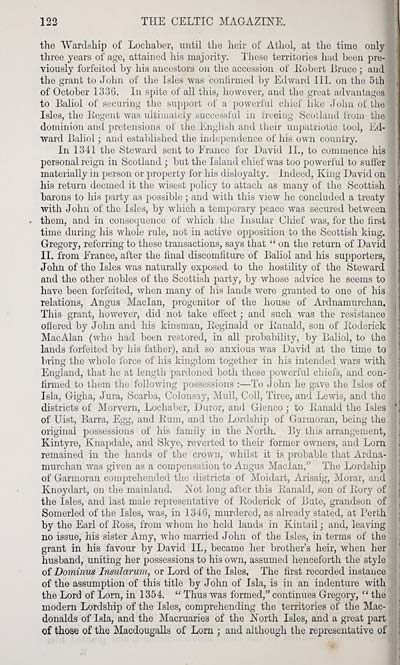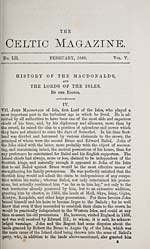Blair Collection > Celtic magazine > Volume 5
(132)
Download files
Complete book:
Individual page:
Thumbnail gallery: Grid view | List view

122 THE CELTIC MAGAZINE. ■
tho Wardship of Lochaber, until the ]ieir of Athol, at the time only-
three years of age, attained his majority. These territories had been pre-
viously forfeited by his ancestors on the accession of iiobert Bruce ; and
the grant to John of the Isles was couiirmed by Edward III. on the 5lh
of October 1336. In spite of all this, however, and the great advanta,nfs
to Ealiol of securing the support of a powerful chief like John of the
Isles, the Kegent was ultimately successful in freeiug Scotland from the
dominion and pretensions of the English and their unpatriotic tool, Ed-
ward Baliol • and established the independence of his own country.
In 1341 the Steward sent to Erance for David II., to commence his
personal reign in Scotland ; but the Island chief was too powerfid to suii'er
materially in person or property for his disloyalty. Indeed, King David on
his return deemed it the wisest policy to attach as many of the Scottish
barons to his party as possible ; and with this vj'ew he concluded a treaty
with John of the Isles, by which a temporary peace was secured between
them, and in consequence of which the Insular Chief was, for the first
time during his whole rule, not in active opposition to the Scottish king.
Gregory, referring to these transactions, says that " on the return of David
XL from Erance, after the final discomfiture of Baliol and his supporters,
John of tho Isles was naturally exposed to the hostility of the Stewanl
and the other nobles of the Scottish party, by whose advice he seems to
have been forfeited, when many of his lands were granted to one of liis
relations, Angus Maclan, progenitor of the house of Ardnamurchan.
This grant, however, did not take effect ; and such was the resistance
offered by John and his kinsman, Pteginald or Eanald, son of Eoderick
MacAlan (who had been restored, in all probability, by Baliol, to the
lands forfeited by his father), and so anxious was David at the time to
bring the whole force of his kingdom together in his intended wars Avith
England, that he at length pardoned both these powerful chiefs, and con-
firmed to them the following possessions : — To John he gave the Isles of
Isla, Gigha, Jura, Scarba, Colonsay, Mull, Coll, Tiree, and Lewis, and tlie
districts of Morvern, Lochaber, Duror, and Glenco ; to Eanald the Isles
of Uist, Barra, Egg, and Eum, and the Lordship of Garmoran, being tlie
original possessions of his family in the JS^orth. By this arrangement,
Kintyre, Knapdale, and Skye, reverted to their former owners, and Lorn
remained in the hands of the crown, whilst it is probable that Ardna-
murchan was given as a compensation to Angus Maclan," The Lordship
of Garmoran comprehended the districts of Moidart, Arisaig, Morar, and
Knoydart, on the mainland. ^STot long after this Eanald, son of Ilory of
the Isles, and last male representative of Roderick of Bute, grandson of
Somerled of the Isles, was, in 1346, murdered, as already stated, at Perth
by the Earl of Eoss, from whom he held lands in Kintail ; and, leaving
no issue, his sister Amy, who married John of the Isles, in terms of the
grant in his favour by David IE, became her brother's heir, when her
husband, uniting her possessions to his own, assumed henceforth the style
of Dominus Insularum, or Lord of the Isles, The first recorded instance
of the assumption of this title by John of Isla, is in an indenture with
the Lord of Lorn, in 1354. " Thus was formed," continues Gregory, '* the
modern Lordship of the Isles, comprehending the territories of the Mac-
donalds of Isla, and the Macruaries of the JN'orth Isles, and a great part
of those of the Macdougalls of Lorn ; and although the representative of
tho Wardship of Lochaber, until the ]ieir of Athol, at the time only-
three years of age, attained his majority. These territories had been pre-
viously forfeited by his ancestors on the accession of iiobert Bruce ; and
the grant to John of the Isles was couiirmed by Edward III. on the 5lh
of October 1336. In spite of all this, however, and the great advanta,nfs
to Ealiol of securing the support of a powerful chief like John of the
Isles, the Kegent was ultimately successful in freeiug Scotland from the
dominion and pretensions of the English and their unpatriotic tool, Ed-
ward Baliol • and established the independence of his own country.
In 1341 the Steward sent to Erance for David II., to commence his
personal reign in Scotland ; but the Island chief was too powerfid to suii'er
materially in person or property for his disloyalty. Indeed, King David on
his return deemed it the wisest policy to attach as many of the Scottish
barons to his party as possible ; and with this vj'ew he concluded a treaty
with John of the Isles, by which a temporary peace was secured between
them, and in consequence of which the Insular Chief was, for the first
time during his whole rule, not in active opposition to the Scottish king.
Gregory, referring to these transactions, says that " on the return of David
XL from Erance, after the final discomfiture of Baliol and his supporters,
John of tho Isles was naturally exposed to the hostility of the Stewanl
and the other nobles of the Scottish party, by whose advice he seems to
have been forfeited, when many of his lands were granted to one of liis
relations, Angus Maclan, progenitor of the house of Ardnamurchan.
This grant, however, did not take effect ; and such was the resistance
offered by John and his kinsman, Pteginald or Eanald, son of Eoderick
MacAlan (who had been restored, in all probability, by Baliol, to the
lands forfeited by his father), and so anxious was David at the time to
bring the whole force of his kingdom together in his intended wars Avith
England, that he at length pardoned both these powerful chiefs, and con-
firmed to them the following possessions : — To John he gave the Isles of
Isla, Gigha, Jura, Scarba, Colonsay, Mull, Coll, Tiree, and Lewis, and tlie
districts of Morvern, Lochaber, Duror, and Glenco ; to Eanald the Isles
of Uist, Barra, Egg, and Eum, and the Lordship of Garmoran, being tlie
original possessions of his family in the JS^orth. By this arrangement,
Kintyre, Knapdale, and Skye, reverted to their former owners, and Lorn
remained in the hands of the crown, whilst it is probable that Ardna-
murchan was given as a compensation to Angus Maclan," The Lordship
of Garmoran comprehended the districts of Moidart, Arisaig, Morar, and
Knoydart, on the mainland. ^STot long after this Eanald, son of Ilory of
the Isles, and last male representative of Roderick of Bute, grandson of
Somerled of the Isles, was, in 1346, murdered, as already stated, at Perth
by the Earl of Eoss, from whom he held lands in Kintail ; and, leaving
no issue, his sister Amy, who married John of the Isles, in terms of the
grant in his favour by David IE, became her brother's heir, when her
husband, uniting her possessions to his own, assumed henceforth the style
of Dominus Insularum, or Lord of the Isles, The first recorded instance
of the assumption of this title by John of Isla, is in an indenture with
the Lord of Lorn, in 1354. " Thus was formed," continues Gregory, '* the
modern Lordship of the Isles, comprehending the territories of the Mac-
donalds of Isla, and the Macruaries of the JN'orth Isles, and a great part
of those of the Macdougalls of Lorn ; and although the representative of
Set display mode to: Large image | Transcription
Images and transcriptions on this page, including medium image downloads, may be used under the Creative Commons Attribution 4.0 International Licence unless otherwise stated. ![]()
| Early Gaelic Book Collections > Blair Collection > Celtic magazine > Volume 5 > (132) |
|---|
| Permanent URL | https://digital.nls.uk/76450504 |
|---|
| Description | Volume V, 1880. |
|---|---|
| Shelfmark | Blair.6 |
| Attribution and copyright: |
|
| Description | A selection of books from a collection of more than 500 titles, mostly on religious and literary topics. Also includes some material dealing with other Celtic languages and societies. Collection created towards the end of the 19th century by Lady Evelyn Stewart Murray. |
|---|
| Description | Selected items from five 'Special and Named Printed Collections'. Includes books in Gaelic and other Celtic languages, works about the Gaels, their languages, literature, culture and history. |
|---|

